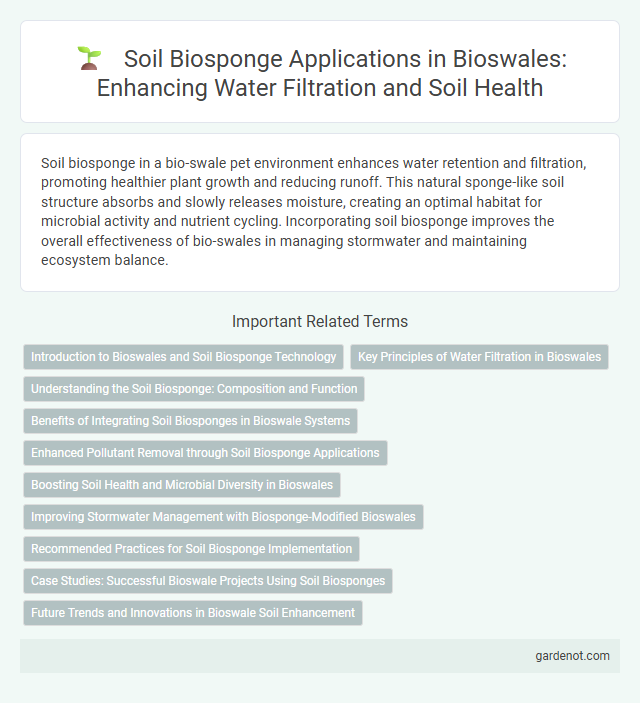Soil biosponge in a bio-swale pet environment enhances water retention and filtration, promoting healthier plant growth and reducing runoff. This natural sponge-like soil structure absorbs and slowly releases moisture, creating an optimal habitat for microbial activity and nutrient cycling. Incorporating soil biosponge improves the overall effectiveness of bio-swales in managing stormwater and maintaining ecosystem balance.
Introduction to Bioswales and Soil Biosponge Technology
Bioswales are landscape elements designed to concentrate and convey stormwater runoff while promoting infiltration and pollutant removal through vegetated channels. Soil biosponge technology enhances bioswales by incorporating engineered soil mixtures with high porosity and organic matter, increasing water retention and filtration capacity. This approach improves stormwater management by mimicking natural hydrological processes, reducing flooding risks, and enhancing groundwater recharge.
Key Principles of Water Filtration in Bioswales
Soil biosponges in bioswales utilize key principles of water filtration including infiltration, adsorption, and microbial degradation to improve stormwater quality. The porous soil matrix enhances infiltration rates, allowing water to percolate while adsorbing pollutants like heavy metals and nutrients. Microorganisms within the soil biosponge break down organic contaminants, contributing to the natural purification process and preventing runoff pollution.
Understanding the Soil Biosponge: Composition and Function
The soil biosponge is a dynamic mixture of organic matter, microorganisms, and mineral particles that work together to enhance water retention and nutrient cycling in soils. Its sponge-like structure increases porosity, allowing efficient absorption and slow release of water to plant roots, which mitigates drought stress. Key components such as humic substances and mycorrhizal fungi improve soil aggregation and biological activity, driving ecosystem resilience and productivity.
Benefits of Integrating Soil Biosponges in Bioswale Systems
Soil biosponges enhance bioswale systems by improving water retention and facilitating gradual infiltration, thereby reducing surface runoff and mitigating flood risks. Their high porosity and organic matter content promote microbial activity, which enhances nutrient cycling and supports plant health within the bioswale. Integrating soil biosponges also increases pollutant filtration efficiency, ensuring cleaner stormwater discharge and contributing to overall ecosystem sustainability.
Enhanced Pollutant Removal through Soil Biosponge Applications
Soil biosponge technology significantly improves pollutant removal by increasing soil porosity and enhancing microbial activity within bio-swales. This augmented structure promotes better infiltration and adsorption of contaminants such as heavy metals, nutrients, and hydrocarbons from stormwater runoff. Studies show that soil biosponge amendments can reduce pollutant loads by up to 70%, contributing to more effective water quality management in urban environments.
Boosting Soil Health and Microbial Diversity in Bioswales
Soil biosponge technology enhances soil structure and moisture retention in bioswales, significantly boosting soil health and promoting microbial diversity essential for nutrient cycling. The increased porosity and organic matter content support diverse microbial communities that improve pollutant degradation and plant growth. Implementing soil biosponge in bioswales optimizes stormwater management while fostering a resilient, biologically active ecosystem.
Improving Stormwater Management with Biosponge-Modified Bioswales
Soil biosponge technology enhances bioswales by increasing soil porosity and water retention capacity, effectively reducing stormwater runoff and improving groundwater recharge. Integrating biosponge-modified soils in bioswales maximizes pollutant filtration and minimizes urban flooding risks. This innovative approach supports sustainable stormwater management by optimizing water absorption and promoting healthier soil ecosystems.
Recommended Practices for Soil Biosponge Implementation
Recommended practices for soil biosponge implementation in bio-swales emphasize proper soil texture assessment, ensuring a mix of sand, silt, and organic matter to optimize water retention and infiltration. Incorporating organic amendments like compost enhances microbial activity, promoting soil structure improvement and pollutant breakdown. Regular monitoring of soil moisture and nutrient levels supports maintenance, ensuring the biosponge sustains its hydrological and filtration functions effectively.
Case Studies: Successful Bioswale Projects Using Soil Biosponges
Case studies of bioswale projects using soil biosponges demonstrate significant improvements in stormwater management and groundwater recharge. In urban areas like Portland and Seattle, these projects reduced surface runoff by up to 40% and improved soil permeability, enhancing pollutant filtration and vegetation health. Detailed monitoring revealed that soil biosponges increased water retention capacity by 25%, contributing to resilient green infrastructure systems.
Future Trends and Innovations in Bioswale Soil Enhancement
Soil biosponge technology in bioswales is evolving with advancements in biochar integration and mycorrhizal fungi applications to improve water retention and nutrient cycling. Emerging trends include the use of nanomaterials to enhance soil porosity and pollutant degradation, optimizing bioswale efficiency in urban stormwater management. Innovations also focus on engineered microbial consortia that promote soil health and resilience, supporting sustainable landscape infrastructure.
Soil biosponge Infographic

 gardenot.com
gardenot.com